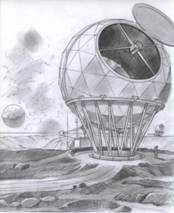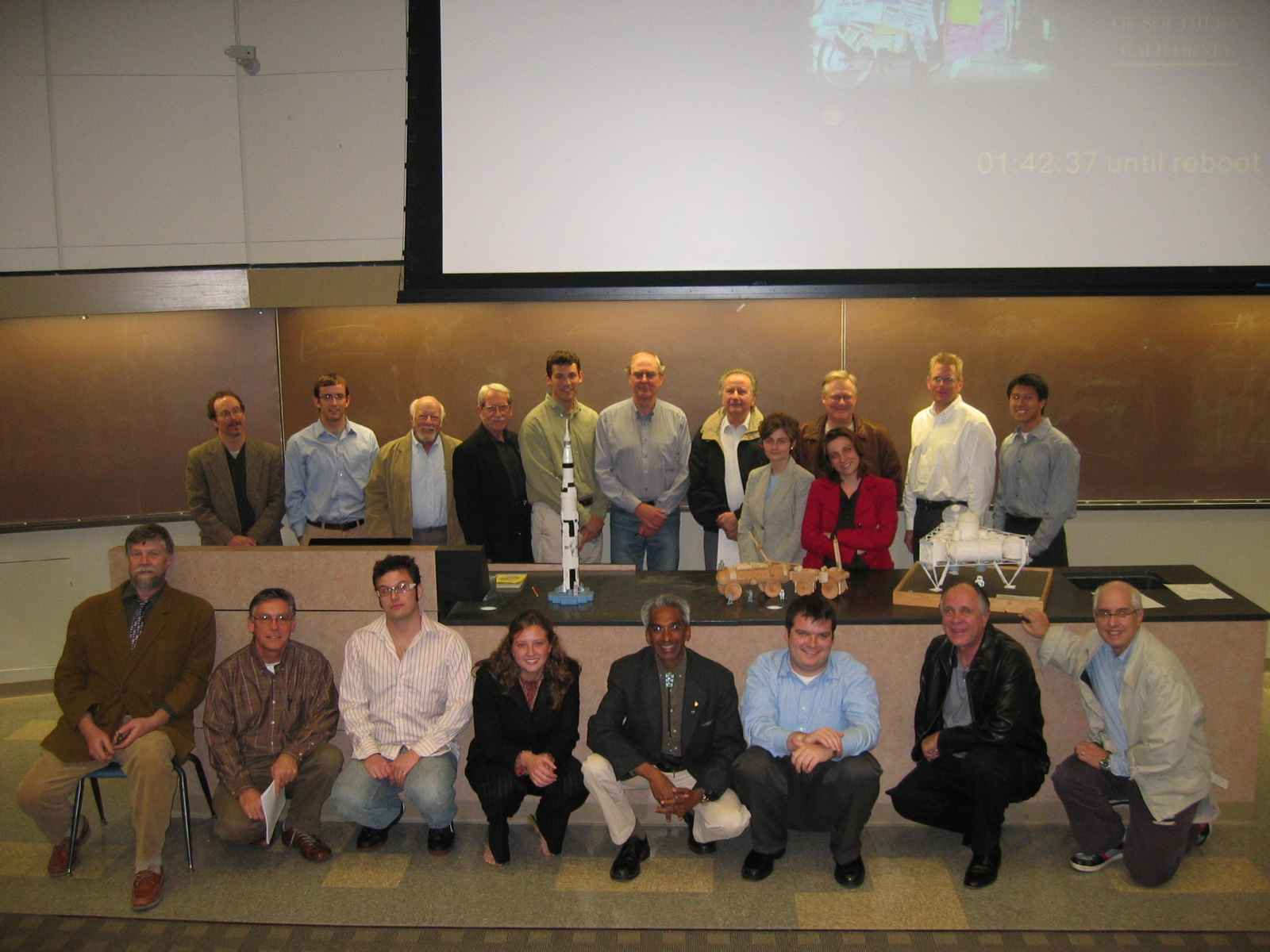Space Studio Architecting
ASTE 527: Space Studio Architecting
About
ASTE 527 is an architectural approach to complex engineering concepts generation. It is a 3 unit graduate elective course offered by the Department of Astronautical Engineering (ASTE).
Design Project Focus
Human Exploration of Space: Return To The Moon
The Bush Administration has tasked NASA with an ambitious human exploration program beyond Low Earth Orbit. NASA Code T was established at headquarters to align critical technologies and systems and chart out very specific, aggressively paced missions to the Moon, leading to returning humans back to the lunar surface by 2015.
NASA’s Exploration Systems Architecture Study (ESAS) details a transportation architecture for landing four crew and 20MT of cargo using a new STS derived crew launcher and HLLV. Studies in progress will describe alternative options for robotic and human lunar surface activities that will provide the critical simulation experience necessary to advance technologies, operational expertise and policy framework for long duration space mission architectures, needed to design, build and commission interplanetary transit vehicles, planetary basing elements and supporting infrastructure.
Using current NASA studies and ongoing projects as a baseline, studio participants will create alternative system architectures (both robotic and human) for lunar exploration and interplanetary mission technology development and verification. The Team Project will focus on a range of cislunar and lunar surface activities. Merits and limitations of different architectures will be discussed and documented. Selected concepts and a Team Project will be presented to NASA Human Exploration Systems Mission Directorate.
Textbooks/References
The Moon: Resources, Future Development and Colonization - Schrunk, Sharpe, Cooper & Thangavelu John Wiley and Sons 1999, ISBN 0-471-97635-0
The Lunar Base Handbook – Peter Eckart, McGraw Hill 1999, ISBN 0-07-240171-0
Spaceflight Life Support and Biospherics – Peter Eckart, Microcosm Press, 1996, ISBN 1-881883-04-3
Space Systems Concepts Creation Class Notes - M. Thangavelu
Textbooks prescribed for the Masters Degree in Astronautics and the Masters Degree in System Architecting are useful. Class handouts will include pertinent material on Space Exploration ranging from history of Lunar Exploration to programs and current thinking on the subject.
Imaginations of Future Visions
Join the Team


- Join the interdisciplinary USC Space Exploration Design Team.
- Participate in a dynamic systems engineering concepts design team environment
- Real-time interaction with NASA and industry professionals in Space Exploration
- Evolve program requirements for space exploration mission scenarios.
- Conceive and design a variety of Space Exploration Vehicles, Facilities and Elements.
- Complex systems ideation: create and visualize synergetic concepts
- Learn inductive, associative, analogous, complex concepts generation skills: concept creation, visualization, graphics, model building and presentation techniques.
- Use heuristic, inductive and architectural form-finding methods to create, evolve, refine and present complex Space Exploration concepts.
- Critiques, reviews and Space Architecture lecture series by panel of experts.
- Present your concepts to NASA Space Exploration Mission Designers
Course Methodology
This highly interdisciplinary course is all about the formulation and articulation of creative ideas. It is also about speculation; visualizing future applications for space technology.
The aim of this synthesis oriented program is to encourage and refine programmatic and conceptual design synthesis skills for the creation of complex high technology projects. Space exploration and space applications are the areas of focus. Inductive and analogous processes, associative logic, metaphorical models and other system architecting tools are employed to quickly create alternative "concept architectures", which in essence, are rudimentary but global ideas or visions of a project. These alternative concept architectures even precede engineering requirement documents and, in fact, they help in critically examining the need for a project and then assist in creating solid requirements through the crucial iterative processes involving inductive reasoning, debate and discussion. This exercise directly contributes to the speedy evolution of resilient "strong boned" complex architectures.
Besides presenting poignant, project specific, interdisciplinary scientific concepts and engineering theory behind space system architectures, participants will be introduced to architectural concept generation theory, methods, form finding processes, visualization and presentation techniques followed by a unique, hands-on studio approach that allows the participants to realize their own concept architecture project in a rapid manner. Participants will work on both a small individual mini project and a larger team project. These concept architectures are then presented to an expert panel of faculty, agency and industry professionals for feedback and discussion. The class will also feature lectures on relevant topics by visiting professionals who are experts in the field.
Individual Project
For the individual mini-project (due at mid-term) participants are free to explore creative, new ideas of their own choice as well for space transport and human and robotic facilities in space. Options for concept architectures include but are not limited to :
- Space Transportation systems and their evolution
- Orbital debris mitigation systems
- On orbit assembly of large scientific platforms, modular stations/vehicles
- Solar Power Satellites
- Innovative communication satellite architectures
- Solar System Exploration strategies and expeditions to the Moon, Mars and beyond
- Recreational vehicles/facilities, advertising in space and other innovative ideas


Instructor Biography
Madhu Thangavelu conducts the ASTE 527 graduate Space Studio Architecting course in the Department of Astronautical Engineering at the University of Southern California. He also teaches the Arch599: Extreme Environment Habitation Design Seminar in the School of Architecture where he is a graduate thesis adviser.
Mr. Thangavelu’s educational background is in Architecture(Masters in Building Science, USC School of Architecture) and in Engineering (Bachelors in Science and Engineering, India). Versions of Madhu's masters thesis(conceived during ISU '88 at MIT) entitled "MALEO: Modular Assembly in Low Earth Orbit. An Alternate Strategy for Lunar Base Establishment" were published in several journals worldwide.
At USC, he was mentored by and worked as a research assistant under Dr.Eberhardt Rechtin, professor of Electrical, Systems and Aerospace Engineering, considered the chief architect of NASA’s Deep Space Network and President Emeritus of Aerospace Corp.
Since 1992, he is a creative consultant to the aerospace industry in this newly evolving field of space architectures complex concept synthesis. Mr. Thangavelu’s concepts have been reviewed and appreciated by NASA, the National Research Council, the National Space Council(Bush Sr. Administration), and his work has been presented before the National Academy of Sciences.
He is a visiting lecturer at the International Space University(ISU) and co-chaired the Space Systems Analysis and Design Department at their 2002 summer session in California. He continues to present and publish original concepts in Space System Architectures and chairs related sessions at conferences. He is a co-author of the book "The Moon: Resources, Future Development and Colonization", John Wiley &Sons 1999, and second edition is in preparation. He is a former Vice Chairman for Education, Los Angeles Section of the American Institute Of Aeronautics and Astronautics(AIAA). He is director of Space Exploration Projects at the California Institute of Earth Art and Architecture.
Most recently Mr. Thangavelu’s concept creation work was greatly appreciated for proposing ideas that pointed to the “leading-edge sensor concept” for return to flight of the space shuttle fleet.
Mr. Thangavelu, his spouse, space system architect Catherine Girardey are both naturalized citizens and live with their children Chloe Saras(12), Chelsea-Manon(9)and O’Paul Roy(3) in Palos Verdes Estates, California.
More Information
- AIAA Space 2010 - The Farm - M.Thangavelu, L.Simurda
- AIAA Space 2010 - The International Space Transit Vehicle - Roukos,M.Thangavelu
- AIAA Space 2010- Ballute Cargo Recovery System for ISS - M Thangavelu D Smith_Ver6-Final
- AIAA Space 2010 -Helium Paper for AIAA (4)-Final-M Thangavelu J Bermudez
- AIAA Space2009 Returntothe Moon Looking Glass 204 cxpaper
- Preliminary Infrastructure Development For Altair Sortie Operations -AIAA Space 2009 Paper final
- Telerobotic Exploration and Development of the Moon 2005
Previous Student Work
During the Fall 2008 semester, the students of the graduate astronautics class ASTE 527 (formerly AME 557), addressed the following question:
What precisely can we do on the Moon, with crew and robots, that can immediately (very short timeframe-2020-2040) benefit not only the science and engineering community, but also inspire humanity as a whole, on a permanent basis?
The Team Presentations:
IntroductionCis-Lunar Ambulance (Nicole Jordan)
Lunar Communications (Amit Patel)
Lunar Geology (Kimberly Albarico)
Lunar Power Peaks (Rajeev Shrestha)
Lunar Rock Transportation & Processing (Corey Harmon)
Lunar SS (Dana Pugh)
Magic Envelope (Brandon Hsu)
SPIDAR (Jodi Enomoto)
Surface Transportation (Melissa Doyle)

